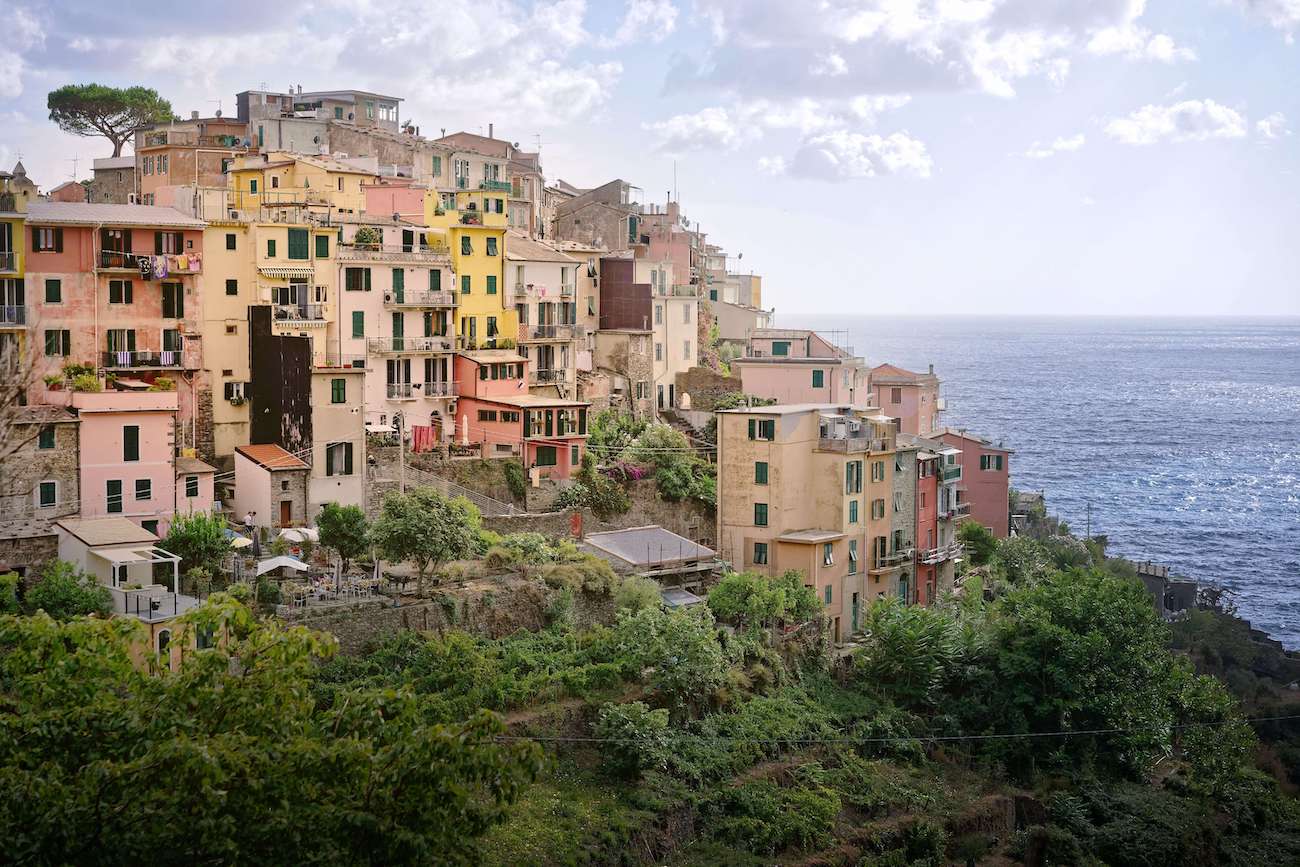Hiking the Cinque Terre in Italy is nothing short of intoxicating. The trail connecting the five picturesque and multicolored villages leads you up and down the jagged ridges of this stretch of Liguria’s coast. You walk surrounded by Mediterranean scrub and vineyards, standing out on the sea’s cobalt blue background. But what’s the best way to plan the Cinque Terre hike?
Where is the Cinque Terre?
The Liguria region is a narrow strip of land in northern Italy extending from the French border to Tuscany, southwest. The area called Cinque Terre, a group of five tiny towns perched on the cliffs diving into the sea, is at the far southern end of Liguria, close to where Tuscany begins. The easiest access points are Florence (about 190 km, 118 mi) and Milan (about 240 km, 150 mi). You can get to the Cinque Terre by car or by train, but keep in mind that you won’t be able to drive between the villages since the road is high up.
Best time to hike the Cinque Terre
The best months for trekking in the Cinque Terre are April, May, September, or October. The temperatures are still mild, and you should also find fewer tourists. In the height of summer, some parts of the trails can get extremely crowded.
In case your only option is to hike the Cinque Terre in summer, start early in the morning to avoid as much as possible the scorching heat, especially since there’s not much shadow. Also, bring a decent amount of water to keep hydrated.
Winter is cooler and less crowded, but it is not uncommon for heavy rains to cause landslides and hiking conditions that are not entirely safe (keep in mind that in case of bad weather, the trails may be closed).
IMPORTANT NOTICE: The Cinque Terre is frequently exposed to landslides following strong rainfalls. For this reason, some sections of the Blue Trail are temporarily closed. Before you plan your hike, check the current status on the Parco Nazionale Cinque Terre website.
Which equipment?
With the exception of a couple of stretches (more on that later), don’t underestimate the Cinque Terre hike, and plan to have the right equipment. It’s definitely not a trail you’ll want to walk with flip-flops, as you’ll climb up and down. Furthermore, according to the National Park regulations, access to the network of paths is prohibited to people wearing open footwear, and/or shoes with smooth soles. Meaning that you must be equipped with a “Vibram” type sole, are. If you violate the rule, you’ll be fined (and possibly not even allowed to access the trails).
I have my personal day hike packing list, and while it’s mostly intended for the mountains and higher altitudes, there are a few items I always pack, regardless of the hike.
Essential items to hike the Cinque Terre include good, sturdy hiking shoes (I’m very happy with my La Sportiva), sunscreen, bug repellent, and Compeed cushions, in case you get blisters. You won’t want to spoil your hike because your feet are hurting! Foldable hiking sticks will certainly reduce the impact of the steep descents on your knees.
Cinque Terre hike: which is the best trail?
There’s often a bit of confusion as to which is the best path to walk since there are several options. Furthermore, this area is sadly often prone to landslides. The result is that some stretches of the trail may be closed.
You can walk the Blue Trail both from East to West and vice versa. I suggest you hike from Monterosso to Riomaggiore for a couple of reasons. First of all, you’ll get to climb up the steepest stretches of the trail, rather than climbing down, which is much better for your knees. Also, I prefer to start with the most challenging sections rather than facing them when my legs are tired. Most importantly, you’ll get the best view of many of the five villages as you approach them. Believe me, when the town of Vernazza suddenly appears, it will take your breath away!
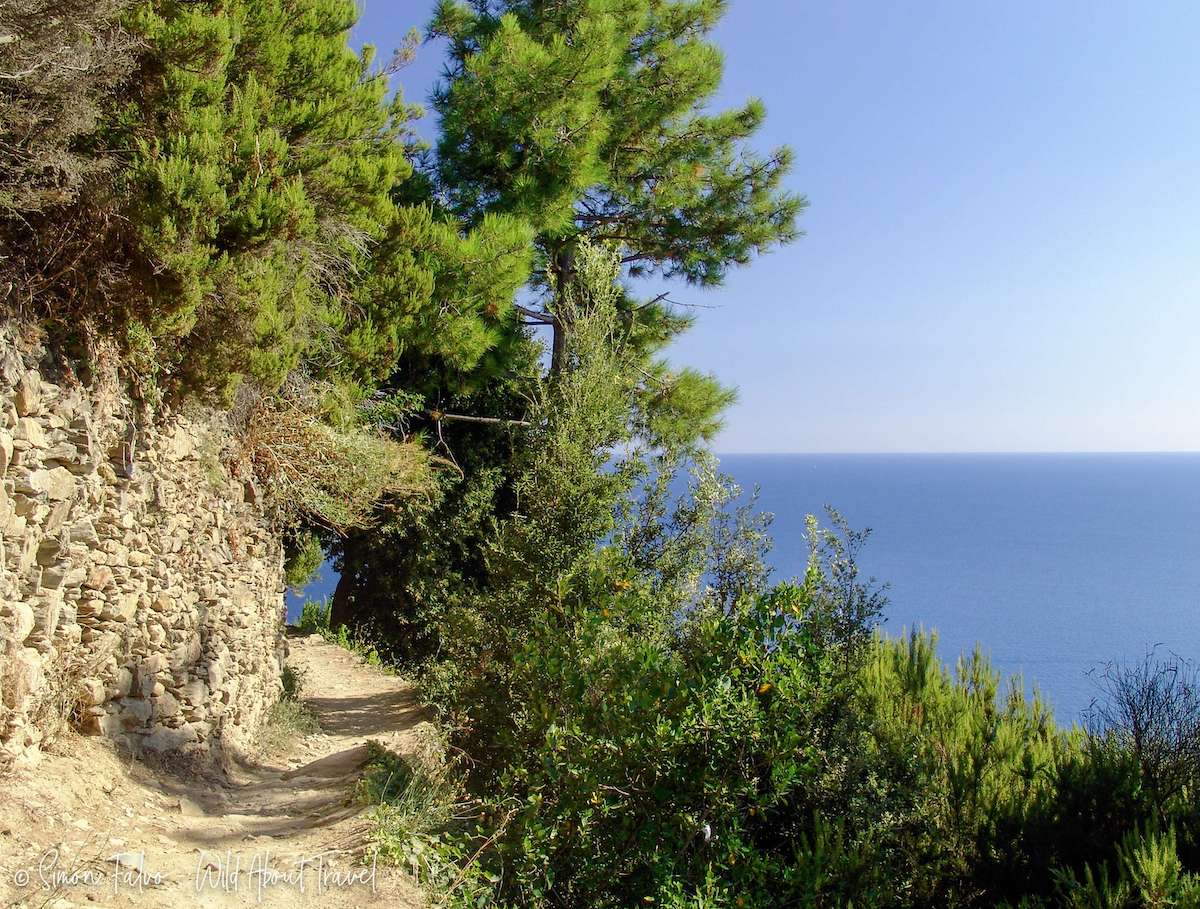
Although there are other options, I recommend you hike the Blue Trail (Sentiero Azzurro), which offers spellbinding scenic views of the jagged coast and the colorful villages.
To walk the Blue Trail, you need to buy the Cinque Terre Card, whose proceeds ensure the maintenance of the hiking paths and other services within the National Park. There are several options, for one or multiple days, as well as integrated tickets allowing free access to the local trains. The price for one adult and one day is 7.50 euros. You can buy the tickets at the Welcome Centers of the Cinque Terre National Park or online.
Cinque Terre Hiking Map
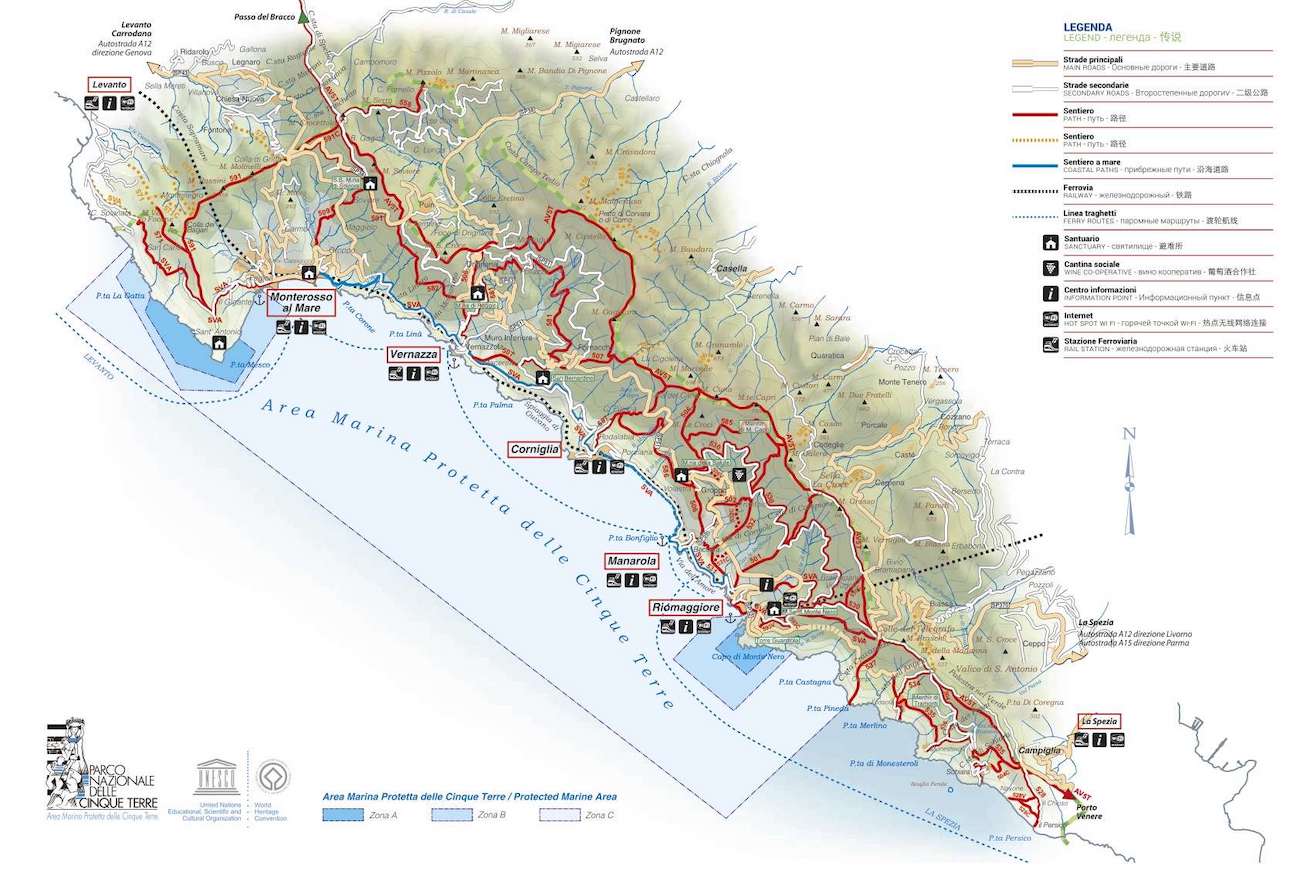
The Cinque Terre Blue Trail
A large portion of the Blue Trail already existed in the Middle Ages. For centuries, it was the only way of communication between the inhabitants of the coast. Dozens of mule tracks crisscross the Sentiero Azzurro, climbing up to the ridge, drawing a dense web of paths through dry stone walls, man-made terraces to cultivate grapes and olives, small inhabited areas, and sanctuaries.
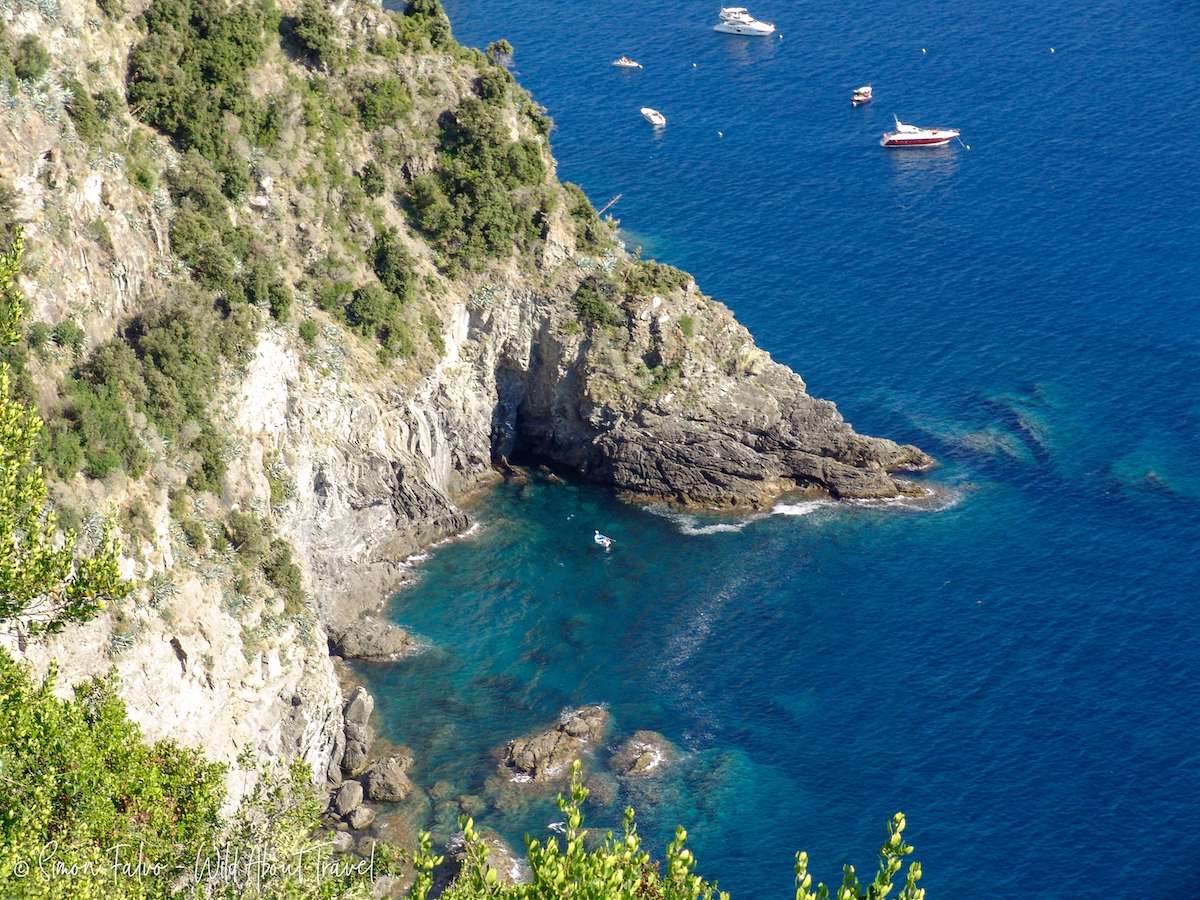
The Cinque Terre Blue Trail (technically marked as itinerary 592) is about 12 km long (7.5 mi) and connects Riomaggiore to Monterosso al Mare passing through the other 3 villages: Manarola, Corniglia, and Vernazza. Some parts of the trail are very easy to walk while other sections climb up and downhill. Spectacular views of the coast will reward your efforts.
Related read: HIKING PORTOFINO: 3 WONDERFUL TRAILS ON THE ITALIAN RIVIERA
If you’re fit, you can walk the entire trail in a single day. However, to better grasp the spirit and the beauty of the Cinque Terre I advise splitting it into a couple of stages. That would allow you to stroll in the tiny streets of the five villages, snap plenty of photos, and sip an aperitif by the sea with the afternoon sun reflecting in the water.
Stage 1 – Monterosso to Vernazza
| Length | 3.7 km (2.3 mi) |
| Elevation | 291 m (955 ft) ⇑ |
| 284 m (932 ft) ⇓ | |
| Difficulty | Medium (EE – Expert hikers) |
| Time | 2 hours 15 minutes |
The leg between Monterosso and Vernazza is probably the most popular and also one of the most strenuous. You’ll climb up and down, including steps and a steep mule track, surrounded by the Mediterranean scrub and the exhilarating scent of the flora mixed with the sea smell. The views of the rugged cliffs diving into the blue sea are one of the most beautiful marine scenery you can imagine. And the most exciting moment is when the village of Vernazza suddenly makes its appearance. Get your camera at hand because it’s impossible not to take photos of the pictures small bay, surrounded by the pastel-colored houses hanging on the bluff.
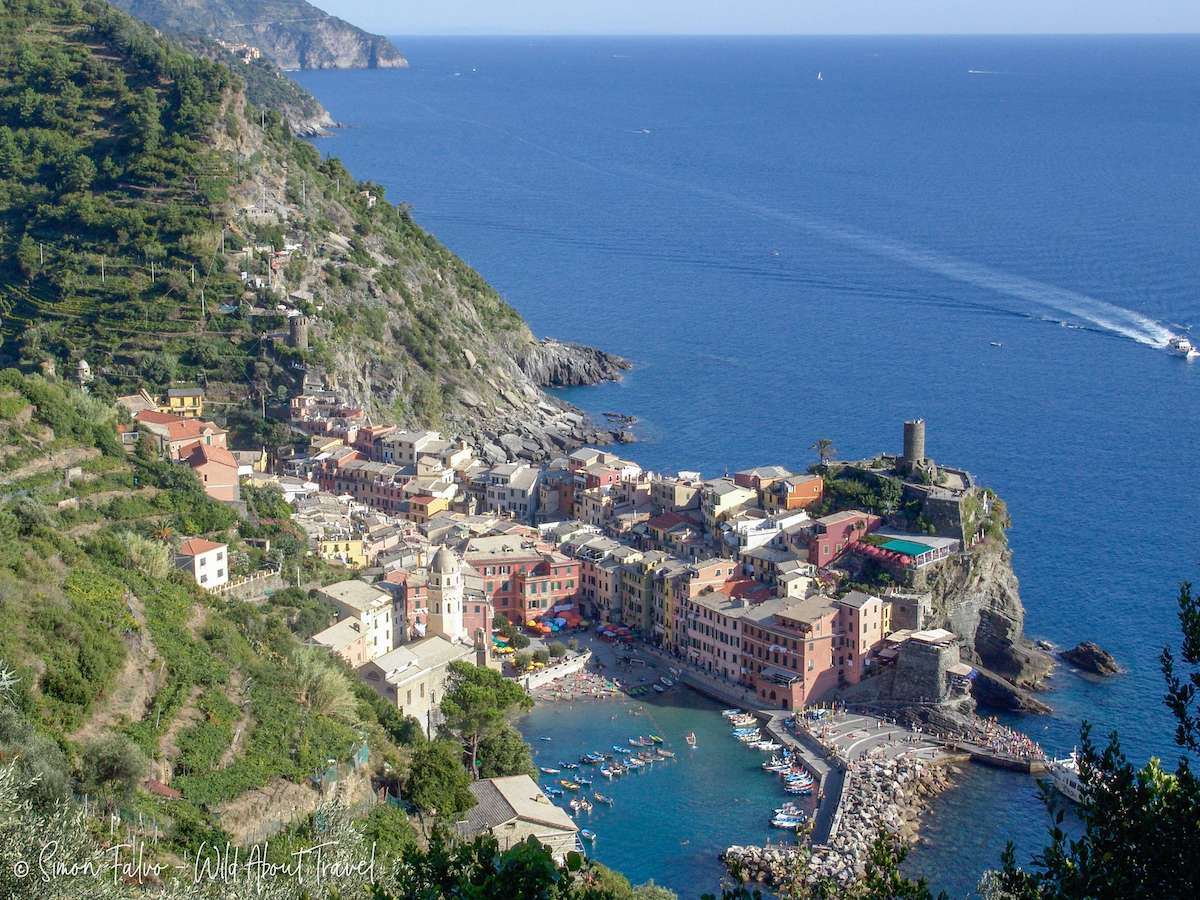
The trail is narrow and often crowded; therefore, I recommend you start walking early in the morning.
Stage 2 – Vernazza to Corniglia
| Length | 3.4 km (2.2 mi) |
| Elevation | 183 m (600 ft) ⇑ |
| 190 m (623 ft) ⇓ | |
| Difficulty | Medium (EE – Expert hikers) |
| Time | 1 hour 45 minutes |
This leg of the Blue Trail is undoubtedly the most spectacular of all; thus it’s very famous among tourists hiking the Cinque Terre. You’ll have truly jaw-dropping views as you walk among olive trees, vineyards, and Mediterranean shrubs.
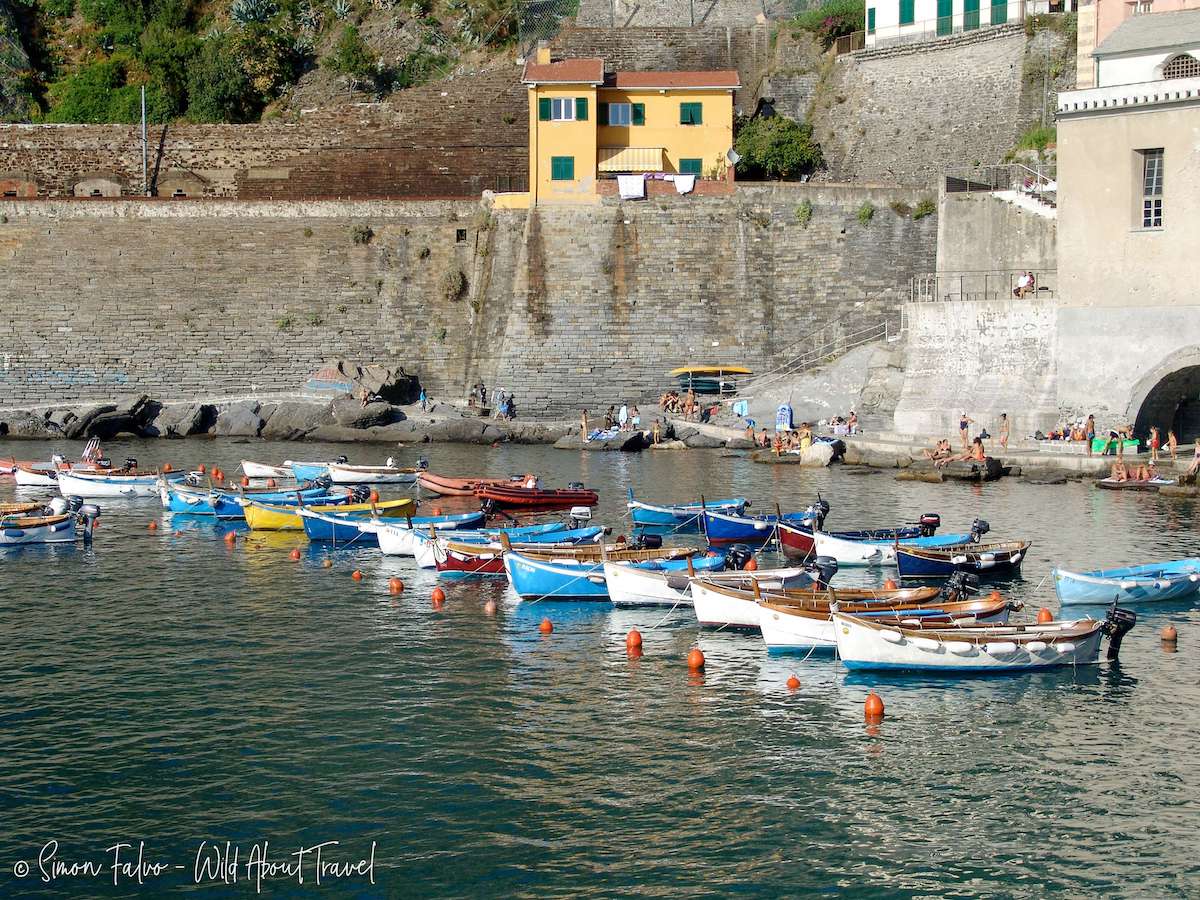
Stage 3 – Corniglia to Manarola
| Length | 2.2 km (1.4 mi) |
| Elevation | 113 m (370 ft) |
| Difficulty | Easy |
| Time | 1 hour 45 minutes |
From Corniglia to Manarola the trail mostly follows the coastline, with limited up and downs. This area is the heart of the Cinque Terre wine production, and you’ll mostly walk surrounded by the numerous vines until you reach Manarola. This picturesque Ligurian village, full of small shops, is characterized by narrow and colorful houses that develop vertically.
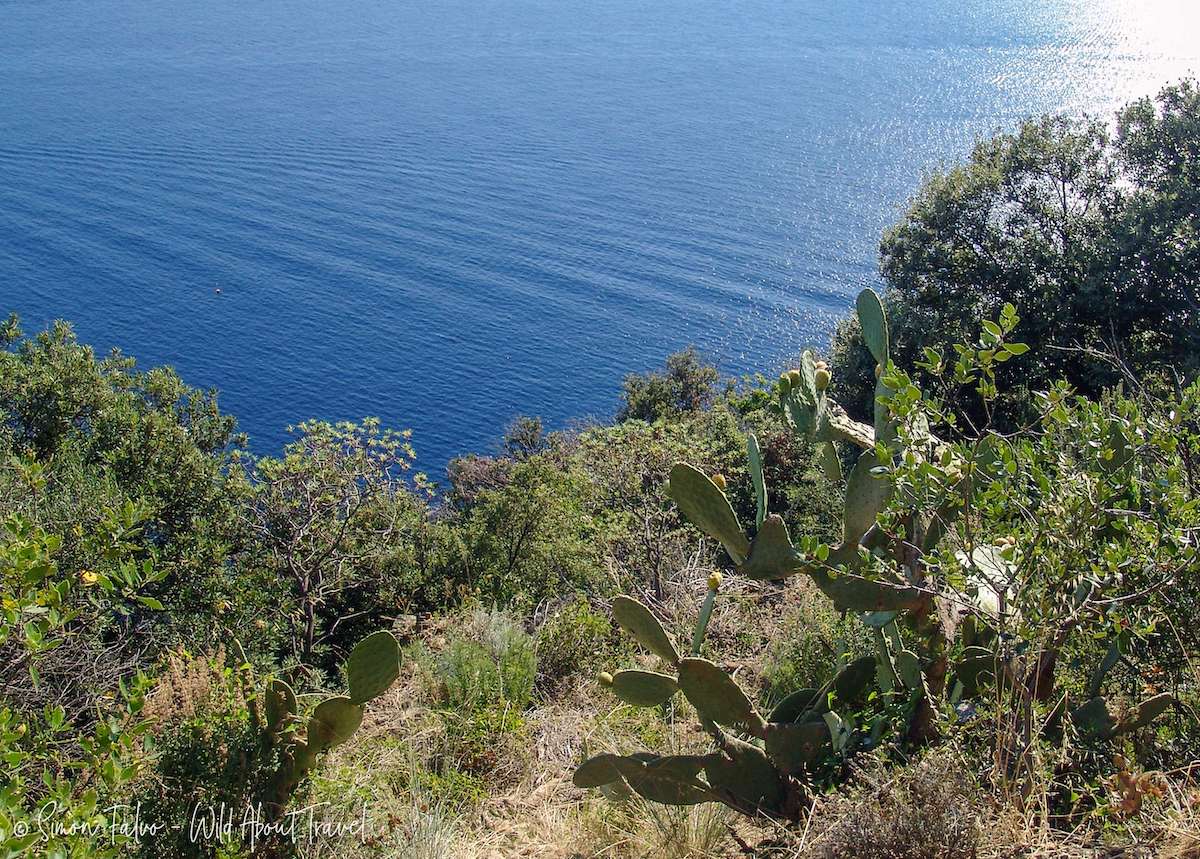
PRO TIP: from my friend Martina who runs the blog Pimp my Trip and lives on the Liguria coast. The most beautiful panorama of Manarola is the one from the small cemetery. You can ask someone how to get there.
Stage 4 – Manarola to Riomaggiore (Via dell’Amore)
| Length | 1.1 km (0,7 mi) |
| Difficulty | Easy |
| Time | 20-30 minutes |
The famous “Via dell’Amore” (The Path of Love) was carved into the rock a few meters from the sea in the years 1926-1928 when the railway was doubled. Well-paved and rather flat, the walk is suitable for anyone, including families with toddlers.
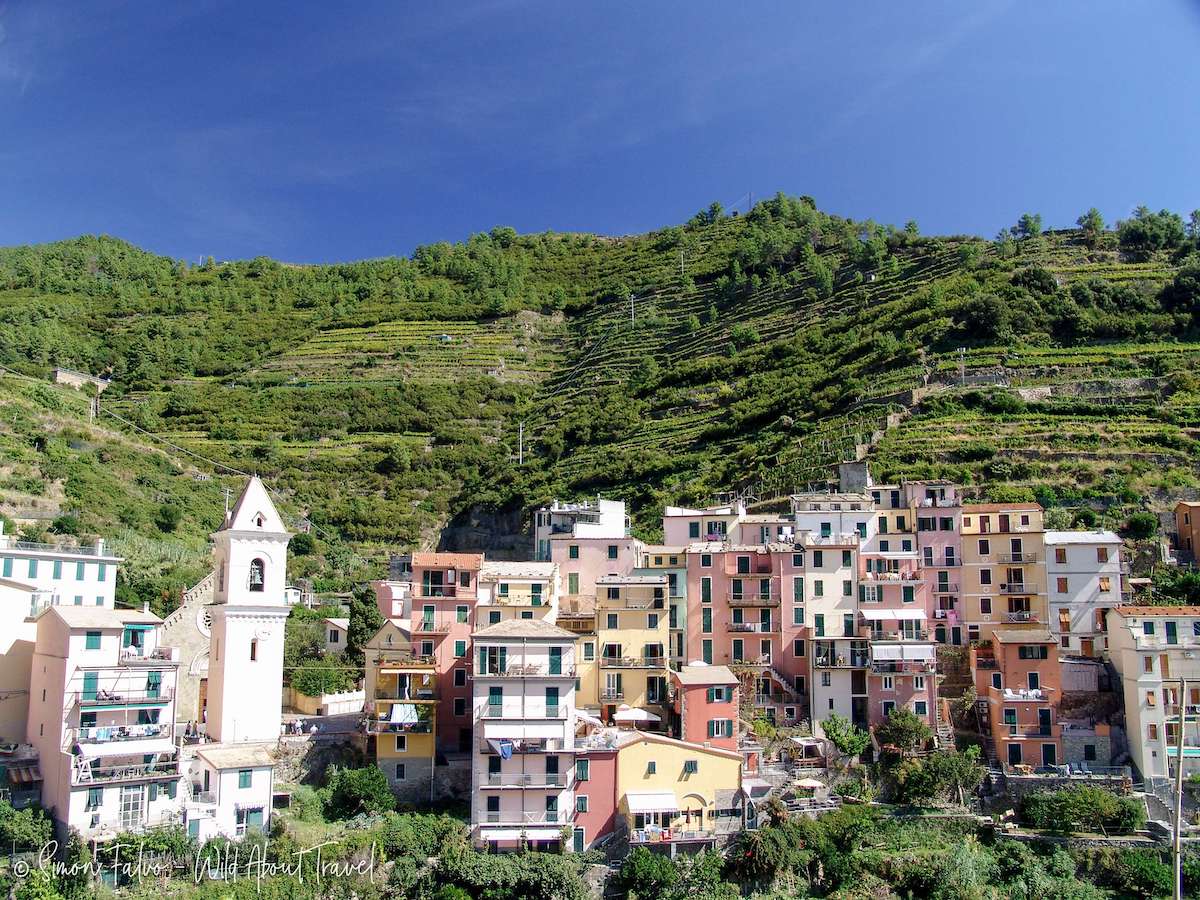
The vegetation is made up of exotic plants such as agaves, pittosporums, prickly pears, and local plants such as sea fennel and rue. You’ll get breathtaking views of the Cinque Terre coastline along the path.
Sadly, the Via dell’Amore is currently closed due to a landslide in 2012. The path is undergoing extensive repair work and is expected to reopen in 2023.
From Riomaggiore to Portovenere
You can make your trip to the Cinque Terre even more memorable by visiting also the nearby Portovenere, one of the loveliest towns on the Ligurian coast.
You can get there by train and bus via La Spezia. Or, if hiking the Cinque Terre was not enough, you can grab your shoes and walk. The trail from Riomaggiore to Portovenere is 13.4 km (8.3 mi) long and as you can expect implies quite a few climbs uphill and downhill. I haven’t walked it yet, but it’s on my list!
Where to stay in the Cinque Terre
Locanda Il Carugio is strategically located in Corniglia, halfway on the Blue Trail. It offers modern and tastefully decorated rooms and beautiful views of the coast.
Hotel Il Colle di Monterosso is located on the heights about 3 km from Monterosso and is the perfect choice if you’re looking for a quiet place. Modern rooms, free private parking, and a garden.
Ca’ D’Andrean, in Manarola, features simple and modern rooms. The hotel is in the center of the village and only a 5-minute walk from the train station.
Albergo Barbara features simple but tasteful rooms and is strategically located in the center of Vernazza.
To know more, read my dedicated post on Where to stay in the Cinque Terre, village by village.
More things to do in the Cinque Terre
Why not add a couple of water activities?
From Monterosso, you can experience a kayak tour with an experienced guide who’ll show you more beauty of this unique area of Italy.
How about a sunset boat tour? You’ll discover the five charming towns of the Cinque Terre from a different perspective, and if you’re lucky, you might even spot dolphins.
Pin for later!
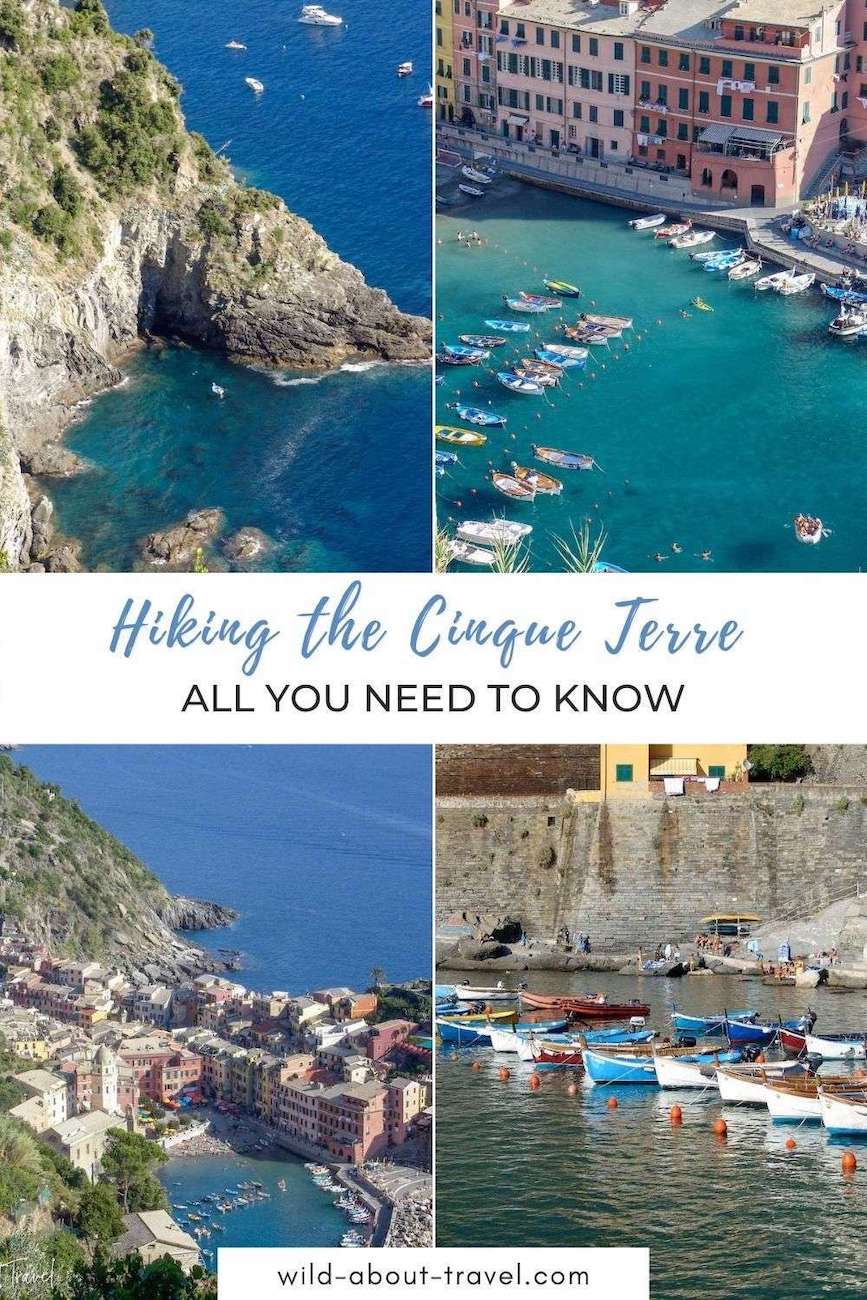
Disclaimer: This post contains a few affiliate links to carefully selected products or services. If you purchase anything, I get a small commission at no extra cost to you. Also, as an Amazon Associate, I earn a tiny percentage from qualifying purchases, while the price for you remains unchanged.

